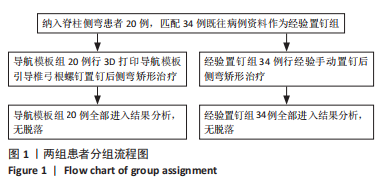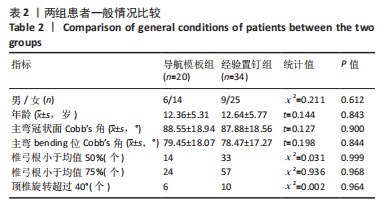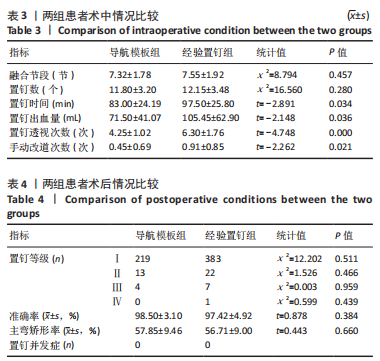[1] SAMDANI AF, RANADE A, SALDANHA V, et al. Learning curve for placement of thoracic pedicle screws in the deformed spine. Neurosurgery. 2010;66(2):290-294; discussion 294-295.
[2] GERTZBEIN SD, ROBBINS SE. Accuracy of pedicular screw placement in vivo.Spine.1990;15(1):11-14.
[3] MIEKISIAK G, KORNAS P, LEKAN M, et al. Accuracy of the Free-hand Placement of Pedicle Screws in the Lumbosacral Spine Using a Universal Entry Point: Clinical Validation. J Spinal Disord Tech. 2015; 28(4):E194-E198.
[4] LIU Z, JIN M, QIU Y, et al. The Superiority of Intraoperative O-arm Navigation-assisted Surgery in Instrumenting Extremely Small Thoracic Pedicles of Adolescent Idiopathic Scoliosis: A Case-Control Study. Medicine (Baltimore). 2016;95(18):e3581.
[5] WU AM, SHAO ZX, WANG JS, et al. The accuracy of a method for printing three-dimensional spinal models. PLoS One. 2015;10(4): e0124291.
[6] SUGAWARA T, HIGASHIYAMA N, KANEYAMA S, et al. Accurate and Simple Screw Insertion Procedure With Patient-Specific Screw Guide Templates for Posterior C1-C2 Fixation. Spine (Phila Pa 1976). 2017;42(6):E340-E346.
[7] 魏巍,邢龙颜,焦甲勋,等.数字化导航模板技术联合颈椎椎弓根螺钉植入的有效性及安全性:前瞻性、单中心、自身对照临床试验方案[J].中国组织工程研究,2017,21(35):5644-5648.
[8] 张树芳,陈荣春,郭朝阳,等.基于3D打印技术选择性椎弓根螺钉治疗青少年特发性脊柱侧凸[J] .中国组织工程研究,2016,20(48): 7225-7231.
[9] 闻志靖,高正超,卢腾,等.导航模板辅助脊柱椎弓根内固定术与传统椎弓根内固定术手术效果比较的Meta分析[J] .中国骨伤, 2018,31(11):1069-1076.
[10] 严斌,孙永建,欧阳汉斌,等.3D打印导航模块辅助腰椎椎弓根螺钉精确植入的应用研究[J] .中国临床解剖学杂志,2017,35(2):156-159.
[11] 李洪珂,董胜利,刘帅,等.3D打印导航模板辅助置钉在脊柱侧弯术中的应用价值[J].生物医学工程与临床,2022,26(3):300-306.
[12] 王飞,刘志斌,张建华,等.3D打印导航模板在辅助寰枢椎椎弓根螺钉置入中的应用价值[J] .中国脊柱脊髓杂志,2017,27(1):61-68.
[13] 杜心如,赵玲秀,张一模,等.胸腰椎椎弓根内径的测量及其临床意义[J] .中国脊柱脊髓杂志,2001,11(3):162-164.
[14] 史亚民,柴伟,侯树勋,等.胸椎椎弓根形态测量研究[J].中国脊柱脊髓杂志,2002,12(3):191-193.
[15] 石锐,刘浩,袁元,等.不同节段椎弓根内部结构的测量和比较[J].中国临床解剖学杂志,2005,23(5):458-462.
[16] 侯树勋,史亚民.国人下胸椎及腰椎椎弓根形态学特点及其临床意义[J].中华骨科杂志,1994,14(4):222-225.
[17] KOTANI Y, ABUMI K, ITO M, et al. Accuracy analysis of pedicle screw placement in posterior scoliosis surgery: comparison between conventional fluoroscopic and computer-assisted technique. Spine (Phila Pa 1976). 2007;32(14):1543-1550.
[18] RAO G, BRODKE DS, RONDINA M, et al. Inter- and intraobserver reliability of computed tomography in assessment of thoracic pedicle screw placement. Spine (Phila Pa 1976). 2003;28(22):2527-2530.
[19] FISHER CG, SAHAJPAL V, KEYNAN O, et al. Accuracy and safety of pedicle screw fixation in thoracic spine trauma. J Neurosurg Spine. 2006;5(6):520-526.
[20] KIM YJ, LENKE LG, BRIDWELL KH, et al. Free hand pedicle screw placement in the thoracic spine: is it safe? Spine (Phila Pa 1976). 2004; 29(3):333-342.
[21] SUGAWARA T, HIGASHIYAMA N, KANEYAMA S, et al. Multistep pedicle screw insertion procedure with patient-specific lamina fit-and-lock templates for the thoracic spine: clinical article. J Neurosurg Spine. 2013;19(2):185-190.
[22] NIU G, CHENG J, LIU L, et al. Individualized 3D printed navigation template-assisted atlantoaxial pedicle screws vs. free-hand screws for the treatment of upper cervical fractures. Front Surg. 2022;9:932296.
[23] LU C, MA L, WANG X, et al. Comparison of 3D-printed Navigation Template-assisted Pedicle Screws versus Freehand Screws for Scoliosis in Children and Adolescents: A Systematic Review and Meta-analysis. J Neurol Surg A Cent Eur Neurosurg. 2023;84(2):188-197.
[24] 李玉伟,王海蛟,崔巍,等.O-arm导航、3D打印导板及C型臂X线机辅助下寰枢椎螺钉置入的准确性比较[J]. 中国脊柱脊髓杂志, 2023,33(1):9-18.
[25] 余城墙,韦建勋.3D打印技术在脊柱外科围手术期应用的研究进展[J]. 中国脊柱脊髓杂志,2019,29(3):275-278.
[26] 王力航,陈啟鸰,陆廷盛,等.头盆环牵引治疗重度僵硬型脊柱侧后凸伴复杂椎管内畸形的临床研究[J]. 中华外科杂志,2021,59(5): 370-377.
[27] 李洪珂,郝申申,王鹏程,等.3D打印导航模板辅助特发性脊柱侧弯椎弓根螺钉置入的准确性[J]. 中国组织工程研究,2020,24(30): 4757-4762. |









